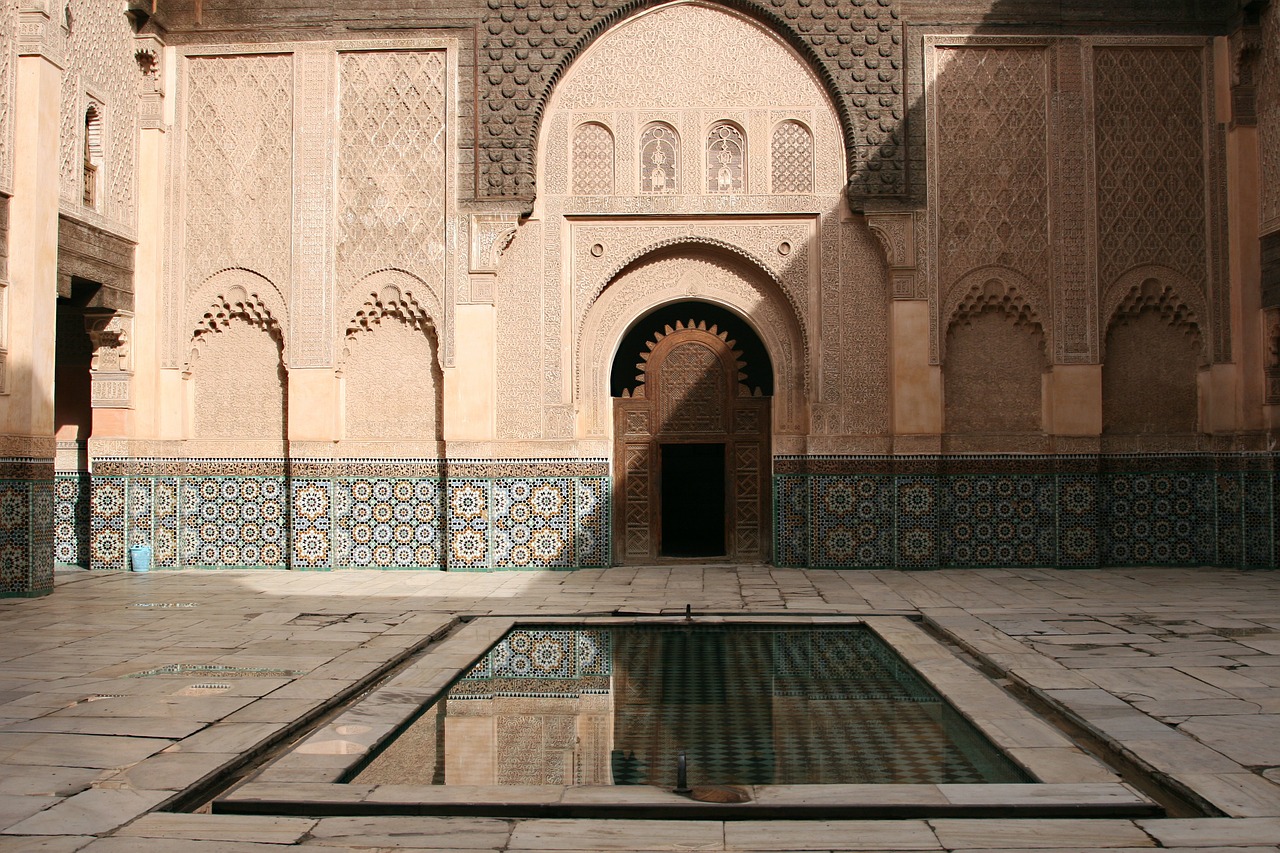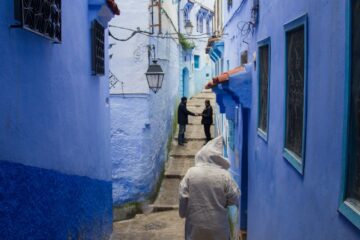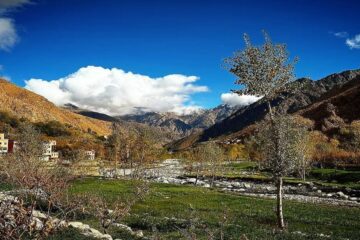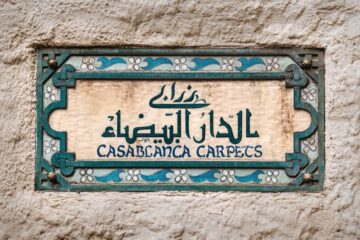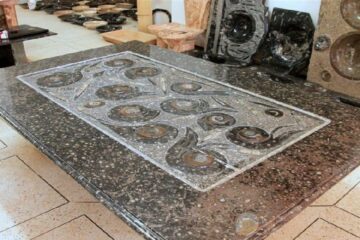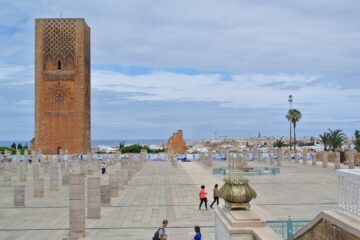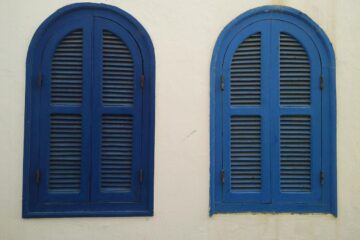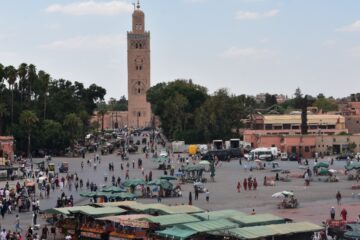Unique, stunning, and breathtaking. Even though it is quite challenging, when knowing the most travel tips to consider, where to stay, and what to visit, Touring Morocco becomes much easier.
Around 225 BCE, the Berber kingdom of Mauretania, which had previously been a component of the Carthaginian Empire, became the first independent Moroccan state. Although the Muslim invasion of North Africa was well underway by the 7th century CE, that kingdom finally became a Roman colony. Morocco was a French Protectorate from 1912 until 1956, after which it attained independence and has been a sovereign nation.
Your stay in Morocco will be fantastic. You will like couscous, enjoy mint tea, go hiking, and admire the frantic sights and noises of the landscape.
Morocco is a magnificent nation that enthralls, with its lofty Atlas Mountains, desert, and coastlines. The enormous, chaotic Medinas might really try your patience, but every time you visit them, your senses are rewarded.
These Morocco travel tips will help you organize your trip, experience the best that the nation has to offer, save money, and stay away from frequent traps that trap unwary tourists.
Top 16 things to do in Morocco
1. Visit the red city of Marrakech
Visit the Jemaa El Fna square, which is home to unique street performers, tattoo artists, musicians, and chefs. Later, visit the Medina and the souks, dine at the market, see the ancient city, and experience Morocco’s most cosmopolitan metropolis. Marrakesh has everything.
2. Sleep in the Sahara desert of Merzouga
The Sahara is wide, desolate, and breathtaking. Spending the night in a desert camp is one of the best activities to try. We strongly advise you to do the same. The stars are endless, and there is no light pollution to obscure them. When you get to the camp, you will be served fresh mint tea. At night, Locals will play Berber music for you.
For a memorable night in the desert, I recommend staying at one of these camps:
- Camel Trips Luxury Camp.
- Milkyway Desert Camp.
- Magic Luxury Camp.
- Desert Luxury Camp ( the best in the region).
3. Admire the blue city of Morocco, Chefchaouen
Chefchaouen is a little town in the heart of the Rif Mountains. It’s quite laid-back, has acceptable lodgings, and is aesthetically gorgeous, with the streets and buildings all painted a vivid sky blue. It’s a fun spot to walk about, shop, and drink fresh drinks.
4. Explore the cultural city of Fes
This historic and magnificent city is one of the greatest in the nation. Its winding lanes are packed with delicious scents, mosques, and artisan stores. Though Fes might be intimidating at first, it’s just amazing if you get acclimated to the speed of the city.
5. Try the Moroccan Hammam
A hammam is a kind of steam bath that is popular in Maghreb countries. They are often located near mosques or toiletries and may be posh or traditional. We recommend that you take a traditional bath with minimal frills for a real and enlightening experience. Traditional Public hammams cost about 10 MAD, and luxury hammams cost between 250 – 300 MAD.
6. Wander the old Medinas
The Medinas are the ancient center of each Moroccan city, consisting of a residential sector, a retail center, and a food market. Shops, restaurants, shops, and residences line the winding and turning streets in structures that seem to be too close together and too ancient to last much longer. The Medinas were paradise for someone who enjoys getting lost. Caution: The Fez Medina is dangerous, so avoid venturing too far off the established route. Stick to busy streets or hire a tour guide to show you the place.
7. Hike the High Atlas mountains
The steep and magnificent High Atlas Mountains run over 2,400 kilometers) from Morocco’s west coast to Tunisia across Algeria. Hiking is possible all year, however, the optimum season is from April to May. Some of the most popular places to hike in the High Atlas mountains are the Todra and Dades gorges.
8. Pay a visit to Hassan II mosque in Casablanca
The Hassan II mosque in Casablanca is a massive architecture with a 60-story-tall minaret. It is Africa’s second-largest mosque and the world’s 7th largest. The walls are built of marble, and the ceiling can be lowered. This intricate architectural marvel took hundreds of Moroccan artisans five years to complete. It has stunning mosaics, plaster moldings, marble and stone columns and flooring, and wood ceilings. It can accommodate 105,000 worshippers! The combined admission to the mosque and museum is 140 MAD.
9. Take cooking classes
Moroccan cuisine is a fusion of Berber, Arabic, Turkish, Middle Eastern, and French influences. In main cities like Marrakesh and Fes, several hotels and guesthouses offer classes to teach cooking Moroccan traditional food. You can cook a classic meal with fresh ingredients from the local market.
10. Visit the Kasbah of Les Oudayas
This 12th-century Kasbah is situated in Rabat’s historical district. The fortress, with its tiny alleyways of white buildings, is a beautiful area to walk about and snap photos. Its elevation provides stunning views of the river and ocean.
11. Try surfing in coastal cities
Surfers all around the world love Morocco. Winter months are ideal for visiting since the waves are larger and more constant, and the air and water temperatures are warm. To catch some of the greatest surf in the nation, go to Taghazout, the most popular surf village. A week at a surf camp, including instruction, equipment, lodging, and airport transportation, costs roughly 5,000 MAD.
12. Head to Tangier in the north
This significant Moroccan city is situated in the north, near the western entrance to the Strait of Gibraltar. Because of the city’s position, Tangier has been influenced by various civilizations and cultures since at least the 10th century BCE. Tangier was an international zone independent from Morocco from 1924 to 1956, and it became a popular destination for many European and American diplomats, businesspeople, authors, and spies during this period. The Grand Mosque, the Kasbah, and a walk along the coastal promenade are must-sees.
13. Visit the Atlas studios in Ouarzazate
Atlas Film Studios, named for its closeness to the Atlas Mountains, is the world’s biggest film studio, occupying more than 322,000 square feet of desert near the city of Ouarzazate. Lawrence of Arabia, The Mummy, and a portion of Game of Thrones were all filmed there. Visit the adjacent Ksar of At Benhaddou kasbah as well! It influences how people envision a ksar (fortified settlement).
14. Admire the Roman ruins of Volubilis
Volubilis, a significant commerce town and the southernmost village during Roman times, is one of the world’s best-preserved (and least-visited) ancient remains. It was founded in the third century BCE as the capital of the ancient kingdom of Mauretania, and it grew much more under Roman control. The entrance fee is 70 MAD.
15. Pay a visit to the Medina of Meknes
Enjoy a pleasant walk in Meknes’ Medina without being bothered. This traditional market in Central Morocco offers Meknes goods such as needlework and others. This is the place to go if the Medinas of Fez and Marrakesh overwhelm you.
16. Head to Essaouira city
Essaouira, on the Atlantic coast of Morocco, is a famous beach location for visitors, particularly Brits. You will enjoy the city’s easygoing vibe, the absence of aggressive touts, the sea air, and the abundance of fresh seafood. Visit the town’s excellent fish market, where all the little fisherman sells their catch of the day. Following that, visit the surrounding little fish shops in the main plaza, where you can taste fresh, grilled seafood for a low price.
Morocco travel prices
Accommodations
Dorm rooms with 6 or 10 beds range between 80-110 MAD per night in major cities like Marrakech and Fes, and 50 to 60 MAD in smaller cities. Private rooms in hostels are from 260 to 380 MAD. Free Wi-Fi is usual, and many hostels also provide complimentary breakfast.
A double room in a cheap hotel in Marrakech or Fez costs roughly 270-410 MAD per night. Expect standard facilities like as free Wi-Fi, TV, complimentary breakfast, and, in certain cases, an outdoor pool.
For individuals traveling with a tent, wild camping is permissible in Morocco. Locals normally don’t want visitors camping on or near their land, so only use this if you’re not going to bother anybody. Expect nomads or cops to pop by to check on you.
Food
Moroccan food is a vibrant, tasty blend of Berber, Andalusian, and Mediterranean traditions, with a dash of French and Sub-Saharan cuisine thrown in for good measure. Because it is a spice country, anticipate delectable dishes at every step. Beef, goat, and lamb are some of the most popular meats served with couscous. Because of the country’s position on the coast, fish such as mackerel and anchovy are also extremely plentiful. Pastilla, a pastry stuffed with meat or fish, is a must-try.
Eating in Morocco may be quite inexpensive, particularly if you dine at one of the numerous markets. A cup of mint tea can set you back between 8 and 10 MAD. Indulge in local cuisines, such as the renowned Tajine, a meat and vegetable meal that costs from 35-55 MAD. Sandwiches, pizza, and the majority of other foods cost between 30 and 50 MAD.
In coastal locations like Essaouira, a fish meal costs about 100-150 MAD, while a lobster costs around 350-400 MAD. Drinks, salad, and bread are included with seafood feasts.
Expect to pay at least 150 MAD or more per main meal at more touristic or Western establishments.
Beer and wine are roughly 70 MAD per drink (although there aren’t many chances to drink in Morocco, so I wouldn’t consider it into your budget).
There’s no need to purchase groceries here since the food is inexpensive and eating out is significantly more convenient! If you do, expect to spend about 200 MAD each week on food like pasta, veggies, poultry, and other basic commodities.
Activities
In major tourist sites like Marrakesh, guided group excursions to sights, shops, and the medina cost between 900 and 1,050 MAD, while a half-day trip costs between 500 and 720 MAD. A soak and spa treatment in a local hammam (bathhouse) may cost as low as 10 MAD and as much as 500 MAD. Prices for Sahara tours vary greatly but plan to spend at least 500 MAD.
Budgets for Travelers in Morocco
Be prepared to spend roughly 285 MAD per day on a traveler’s budget. This implies you’re sleeping in a hostel, eating at street markets and making some meals, using public transportation, and sticking to free and inexpensive activities like free walking tours and local hammam sessions.
At a mid-range price of 520 MAD a day, you can sleep in a private Accommodation, dine out for all meals, ride the train between towns, and participate in more paid excursions and activities like museum visits and desert camping.
You may stay in a hotel, dine out anywhere you want, have a few drinks, fly between cities or hire a car, and do whatever excursions and activities you like on a high budget of 1,150 MAD or more each day. However, this is just the first level of luxury. The only limit is your imagination!
Morocco travel tips on saving money
Morocco is not expensive to visit. However, it is possible to splurge here if you so choose. Here are some of our money-saving recommendations for Morocco:
- Eat at street vendors. Eating inexpensively is incredibly simple in Morocco. While restaurant dinners may cost as low as 30 MAD, street food is significantly less expensive. This is one of the most important Morocco travel tips to consider. Delicious kebabs, sausages, grilled corn on the cob, roasted chicken, enormous sandwiches, and more are available for a few bucks. To spend as little money as possible on food, eat at the local souks in the Medina.
- Negotiate your taxi fee. Before you get into the taxi, be sure to agree on pricing. There is no predetermined pricing, so you must haggle aggressively. So you don’t get ripped off, ask your hotel/hostel staff for pricing estimations.
- Avoid fake guides. Fake guides prowl the Medinas, offering tour services. Say no emphatically while walking away. They are persistent, but if you keep going, they will ultimately give up.
- Be wary of thieves. Petty theft, especially involving wallets, watches, and cameras, is common throughout the country’s busy Medinas. Maintain vigilance and keep your valuables out of sight.
- Avoid drinking. Although drinking is frowned upon in the nation, there are lots of venues where you may do so. They are pricey and the beverages aren’t really nice. Avoid drinking throughout your vacation to save money and get more familiar with local customs.
- Stay with a local. If you want to save money while learning about the place, utilize Couchsurfing. Staying with a native is the ideal way to acquire a sense of the nation while also learning some insider information.
Where to stay in Morocco
Trying to find a place to stay in Morocco? For your next trip to Morocco, here are some of our favorite places to stay in the most important cities in Morocco:
- Marrakech: Riad BB Marrakech.
- Merzouga: Camel Trips Luxury Camp.
- Casablanca: Melliber Appart Hotel.
- Chefchaouen: Casa Perlita.
- Boumalne Dades: Hotel Xaluca Dades.
Morocco travel tips on transportation
Public Transportation. In Morocco, public transportation could be either good or bad. Larger cities, like Tangier and Casablanca, offer public bus services, but the buses are antiquated and overcrowded, and the routes are difficult to navigate.
Instead, most people travel in Petits Taxis. These are compact cars that can seat up to three people and are common across the nation. They are fairly inexpensive, however, there may be a cost after 8 p.m. Negotiate your pricing ahead of time to guarantee you obtain a fair cost.
Taxis with meters are also available in larger cities such as Marrakech. Fares start at 7 MAD and increase by 4 MAD every kilometer.
Grand Taxis. Grand taxis are shared taxis that can transport up to six people and are used to travel greater distances between towns/cities. They will not depart until the cab is filled, although wait periods are normally not too long. You may find one at every taxi stop or bus/train station. If you have a lot of baggage, you may have to pay an additional fee. You should plan your transportation ahead of time.
Bus. Compared to other modes of transportation, intercity buses are a cheap and effective way to go through Morocco. The four most popular operators are as follows: CTM, SATAS, Supratours (regional), and Ghazala (regional).
You will need to purchase your tickets online or at the bus terminal. The websites aren’t very dependable or user-friendly. A 4-hour bus trip from Marrakech to Casablanca costs around 75-110 MAD, whereas a 6.5-hour bus ride from Marrakech to Tangier costs approximately 260-275 MAD.
Train. ONCF operates Morocco’s national rail network, which serves some of the country’s largest cities such as Marrakech, Casablanca, Rabat, Meknes, and Fez. The trains are pleasant and normally on schedule, however, there are rare delays. There is also a high-speed rail line that connects Casablanca and Fez. ONCF has schedules and pricing available.
The 2.5-hour train ride from Marrakech to Casablanca costs around 50 MAD, while the 4.5-hour travel from Marrakech to Rabat costs approximately 150-180 MAD. Going from Casablanca to Fez takes 4 hours and costs between 50 and 120 MAD. It takes 6 hours and charges 195 MAD to go from Fez to Marrakech.
Flying. The largest domestic airline is Royal Air Maroc, and they sometimes offer fantastic deals. A one-hour trip from Marrakech to Casablanca costs around 870 MAD, whereas a one-hour journey from Marrakech to Fez costs approximately 520 MAD.
Car rental. It is not normally suggested in Morocco. Drivers are aggressive, and the number of accidents is high! However, if you want to go off the usual road, this is an excellent option. There are rentals available beginning at 200 MAD per day.
The best time to visit Morocco
Morocco’s shoulder seasons, which range from April to May and September to November, are the finest times to visit. During this season, the temperatures are pleasant and there is less visitor traffic. Taking Morocco travel tips on weather is so much important.
Summer takes place from June through August, and it may be quite hot across the nation during this period, particularly in the south. Many tourists visit the coast to explore cities like Tangier, Rabat, and Essaouira. Expect temperatures to rise over 35°C (95°F).
Winters are pleasant, although nights may be fairly chilly. Temperatures in Marrakech plunge to -3°C (27°F), while the Atlas Mountains experience significant snowfall. Winters are quite damp in the north and towards the shore. Overall, this is not a good moment to be here.
Climbing in the Atlas Mountains is ideal from April to May and September to October. During these periods, the weather is pleasant, with minimal chance of severe weather. Summer is the greatest season to visit the shore since temperatures may reach 27°C (80°F) but the ocean breeze provides plenty of respites.
Safety in Morocco
Morocco is a safe place generally, but visiting here takes caution. Although you are unlikely to be in serious physical danger in Morocco, petty crime and harassment need you to be on alert more than in other nations.
Women going alone draw a lot of attention here, and the possibilities of being followed and perhaps touched are great. This is especially problematic in congested Medinas. One of the most important travel tips to consider for a woman while being in Morocco is to Always keep an eye out and follow your instincts. Bring no valuables and keep your stuff close to your body. Dress modestly and avoid excessive jewelry.
In cities, walking alone at night is often not a smart idea. If you have any doubts about a location, ask the hotel staff if places are safe.
If you need a cab, always negotiate the price ahead of time to prevent being ripped off.
Locals may welcome you inside their stores or offer to show you around while you’re out and about. Always gently but firmly reject, otherwise you may be taken advantage of.
If Traveling to Morocco is on your bucket list, you should definitely consider these travel tips to make the most of your trip.

